Advertisement
Grab your lab coat. Let's get started
Welcome!
Welcome!
Create an account below to get 6 C&EN articles per month, receive newsletters and more - all free.
It seems this is your first time logging in online. Please enter the following information to continue.
As an ACS member you automatically get access to this site. All we need is few more details to create your reading experience.
Not you? Sign in with a different account.
Not you? Sign in with a different account.
ERROR 1
ERROR 1
ERROR 2
ERROR 2
ERROR 2
ERROR 2
ERROR 2
Password and Confirm password must match.
If you have an ACS member number, please enter it here so we can link this account to your membership. (optional)
ERROR 2
ACS values your privacy. By submitting your information, you are gaining access to C&EN and subscribing to our weekly newsletter. We use the information you provide to make your reading experience better, and we will never sell your data to third party members.
Industrial Safety
US Chemical Safety Board finds cascading errors led to fatal incident at BP-Husky refinery
Workers faced confusing ‘alarm flood’ in 12 h period
by Jeff Johnson, special to C&EN
June 27, 2024
| A version of this story appeared in
Volume 102, Issue 20

A mistaken emergency release of more than 10,000 kg of liquid naphtha resulted in the deaths of two workers at a BP-Husky refinery in September 2022, according to a final report by the US Chemical Safety and Hazard Investigation Board (CSB). The investigation found the naphtha formed a vapor cloud that ignited at the Oregon, Ohio, refinery, killing the employees, who were brothers.
The report, released June 24, details a series of cascading events that contributed to the release and fire. It chronicles an “alarm flood” in which more than 3,700 alarms went off in the 12 h period prior to the incident, overwhelming BP operators and causing delays and errors in responding to critical alarms. The CSB also found that the refinery failed to implement a shutdown or issue a stop work order to prevent the accident.
On the day of the incident, a process upset in the facility’s naphtha hydrotreater resulted in the shutdown of several refinery units. Operational decisions caused liquid naphtha to flow to and fill a pressurized vessel that normally held only vaporous gases. BP workers were ordered to quickly drain the vessel, so they released the contents to the ground. The naphtha vaporized and caught on fire. The CSB’s report concluded that the employees may have believed that the liquid was an amine-water solution, not naphtha.
Several recommendations sprang from the report. Among them: better follow-through on safety improvements. BP’s process hazard analyses correctly identified potential risks with the vessel, including handling of overflow events. But the safeguards that refinery managers put in place, such as safety instruments and emergency pressure-relief valves, proved to be inadequate.
Additionally, the CSB notes that BP failed to fully learn from similar previous events. An incident at the refinery in 2019, the report says, also involved the overfilled pressure vessel.




Join the conversation
Contact the reporter
Submit a Letter to the Editor for publication
Engage with us on Twitter